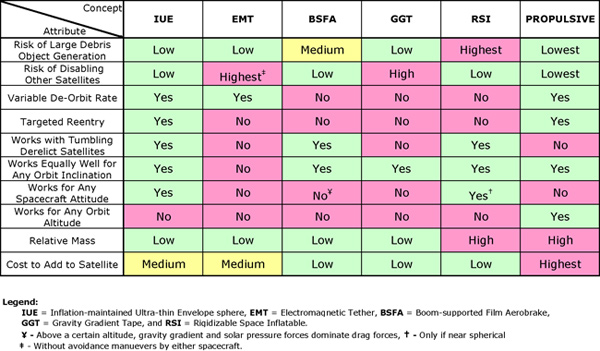De-Orbit Concepts
People have suggested many approaches to de-orbiting space junk, such as using existing on-board chemical propulsions systems, electrodynamic tethers, gravity gradient-oriented drag tapes, boom-deployed drag sails or solar pressure sails. In many cases, while these de-orbit devices are operating there is an increased chance of having a collision with something else, like operating satellites, defunct spacecraft or rocket stages, and creating new junk. For example, because of the extended length of tethers and the characteristic size of typical satellites, independent analysis indicates “tethers several kilometers in length have collision probabilities much greater than those of typical satellites”. (See Patera, R. P., Method for Calculating Collision Probability Between a Satellite and a Space Tether, AIAA Journal of Guidance, Control, and Dynamics Vol. 25, No. 5, September–October 2002).
A risk assessment indicates that tethers are almost as dangerous to operating satellites as the bare satellite and an order of magnitude more dangerous than GOLD.
Although the use of on-board propulsion systems do not increase the chance of creating new debris, many spacecraft do not have such propulsion systems, and for those that do, there is always the temptation to use the propulsion system to extend the mission, depleting the fuel that would be needed to bring the spacecraft down. The GOLD system actually weighs less than the propellant needed to do the same job and it’s very inexpensive, and this means it is more cost-effective to add a GOLD system before launch than to carry the extra fuel.
The table below summarizes the comparison of a number of de-orbit systems with important attributes of interest to satellite and program managers. GOLD is described in the table as an Inflation-maintained Ultra-thin Envelope (IUE) sphere. Propulsive de-orbit offers the least risk and highest flexibility, however, it needs an operating satellite to function, is the most costly if the satellite mission did not originally require it, and is the most massive. The operation of GOLD has a lower risk of disabling other operational satellites and a lower risk of creating large orbit debris objects than competing de-orbit concepts. In addition, GOLD does not require an operating satellite to provide attitude stabilization or power.

|

